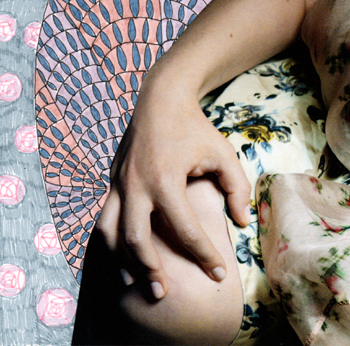 Michelle Casey, “Hands 1", Mixed Media Collage, 4 x 4 inches, April 2014  Michelle Casey, “Hands 2”, Mixed Media Collage, 4 x 4 inches, April 2014 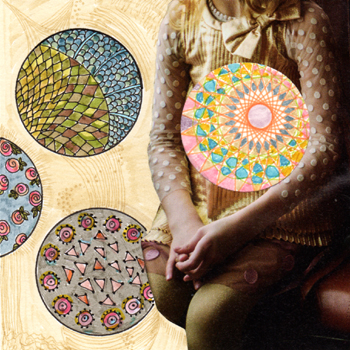 Michelle Casey, “The Universe within Me”, Mixed Media Collage, 4 x 4 inches, April 2014 My apologies for leaving you blogless last week. Today I thought I’d share some recent pieces I’ve been working on with you. Small ones spurred on by my interest in Zentangling and Spirograph. The compositions are simple and playful. I’m working with the theme of hands since I’ve always been attracted to them in drawings and paintings. While they’re all experimental, I felt an interesting theme beginning to emerge once I reached the third piece – the nice thing about working in a themed series; you never know where it will lead you. On a technical note, I added colour and line to them with Tim Holtz Distress markers. These markers come in an attractive array of muted and vintage colours which blend and layer beautifully. If only Holtz’s water-based colours were permanent! As well as the Distress markers, I’ve also used Sakura Pigma Permanent Micron pens which I found worked best on a smooth 140 lb hot press paper; I used Fabriano’s Acquarello water colour Extra white paper. If you’d like some additional tips on pens and markers for your Zentangling or mixed media projects, see CYW member Sheila Cain Samples’ blog entry: Pigment Pens… What Does it All Mean? in which she discusses the differences between dye-based and pigment inks… thanks for unraveling some of the mysteries, Sheila.
PS I still find Beckah Krahula’s One Zentangle A Day an incredible compendium of ideas for taking the craft further. For beginners, I highly recommend Zentangle Basics by Suzanne McNeill.
A Note to New List Members: To those of you who are expecting a complimentary gift from CYW, I haven’t forgotten about you! I hope to have them posted by the end of April. Thanks so much for your patience.
Other Related Links:
The Way of the Zentangle
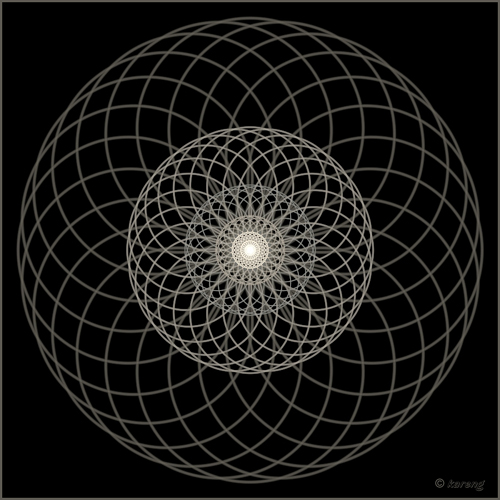 Spirograph by Lupsiberg For a decade now I’ve been frequenting a number of shopping malls in our city. While I enjoy the solitude of working in my studio, I often feel the urge to get out and be amongst people. It might seem strange, but I’ve found I get more writing and reading done in public spaces than at home; distractions like social media and email really eat up my time. I also go walking in these places because it’s part of my exercise routine*; especially in the winter when it’s too messy to walk outside. You might recall from past entries that I’ve been an avid walker ever since I read Julia Cameron’s The Artist’s Way. Walking awakens memories and emotions within me; it helps me solve problems and de-stresses me. I’ve learned as much from my walks in malls as I have from walking in my neighbourhood…
Since I work with images that are fashion-based, shopping centres are the best place to see this world in action. Not just in the stores but on the shoppers themselves. I love to ponder peoples’ lives by the clothes they wear. I also enjoy window displays and learn much from them. For me they are like theatrical sets or art installations. I analyse their construction and often use their visual strategies in my collages. While I can’t afford to buy most of what I see, window shopping is a great way of imagining putting pieces together… (not just clothes but anything you buy); invoking fantasy in this way, is a cool way of composing. As some of you know the latest fashion trend in mixing patterns has also inspired my work. It’s the reason I’m also currently experimenting with Zentangling and working with Spirograph! I love patterns of all kinds so it’s a great excuse to use them in my work. I feel it’s important to work with concepts or techniques that excite you; Like Johanna Basford’s Secret Garden, the Spirograph kit transported me back in time. It was a dream come true when I got my first deluxe Spirograph set for my eleventh birthday. Having recently read physicist Alan Lightman’s The Accidental Universe in which he reflects on multiple views of the universe using art and scientific concepts, I thought it would be interesting to introduce Spirographic designs into my mixed media pieces. They make me think of mathematical studies; I’d love to contrast them with other types of imagery in my work. I’m not sure where I’m headed with these latest obsessions but I’ve decided to follow them anyway. It’s always exciting to embark on a mysterious creative journey. Like life, you never know where it’ll lead you.
Yes, there’s something about the hum of peopled places that both energizes and calms me. My favourite part of mall walking is people watching. Each mall has its own set of unique characters. They spark many ideas within me for collage stories and even words for my pieces. I make sure to have my notebook or cell phone handy so I can jot them down. I think it’s funny how you never notice the same people twice when you go to a shopping centre. There are a few people however I’ve viewed countless times over the years. Memorable characters like an elegantly attired Japanese lady whose life, l sense, is slowly crumbling away. Once a svelte figure adorned in designer outfits and sporting an Audrey Hepburn updo, now she’s put on weight, dons simple clothes and wears her hair in a practical bob. I imagine she’s a dead diplomat’s wife. She sits having a sandwich on a bench oblivious to the world around her. There’s also a man with a droopy Groucho Marx moustache who’s worn the same clothes forever; I get the feeling he still lives with his parents. He seems forlorn; I think he would love to connect with others but doesn’t know how. I imagine him as a high school dropout. These characters are like the Eleanor Rigbys and Father McKenzies of that old Beatles tune “All the Lonely People”. For them the mall is not a space of consumption but a kind of living purgatory. When I see their familiar faces, I want to smile hi but am afraid to. We’re so close and yet so far apart.
All this to say I think it’ll do you good to get out of the studio once in a while and immerse yourself in your local mall culture to discover what kind of stories and ideas you find there. Wendy, Sheila and Maggie, maybe we should incorporate this into our next Muses meeting! Come to think of it, it would be a great workshop/excursion idea. People do Paris, Lisbon and Rome, why not the local mall? 😉
* Here in Ottawa there’s a significant mall walking culture many seniors (and occasionally younger folks) partake in to get a good cardio workout. It’s not like going to a popular fitness centre, it’s more down-to-earth and accessible.
Other Related Links:
Collage Tip #5: A Walk A Day
Tales from the Observer: Pattern Alert!
Tales from the Observer: Art, Display & Installation
The Fabric & Patterns of Everyday Life I
The Fabric & Patterns of Everyday Life II
 “Praying for a Harvest Moon”, 2010 (pictured here) was my first attempt at making a visual prayer. It invoked my fervent desire to attain my creative goals as I approached the mid-point of my life. The most beautiful experience we can have is the mysterious. It is the fundamental emotion that stands at the cradle of true art and true science. Whoever does not know it and can no longer wonder, no longer marvel, is as good as dead, and his eyes are dimmed. It was the experience of mystery — even if mixed with fear — that engendered religion…. (Albert Einstein)
Ever wonder about the power of art? Does it have any mysterious or miraculous properties? Is it more than a configuration of physical materials assembled to reflect beauty or expression? A friend Jeanne-Sylvie told me that art is like a prayer so recently I’ve begun to think more about this…
When I was young, I saw a movie about a young woman who was very ill. Bedridden, everyday she’d gaze out her room window at a beautiful vine that grew on a wall opposite her apartment. One day she told a friend that she sensed the day the last leaf fell from the vine she would die. One cold, windy autumn night, as she lay suffering from pneumonia, only one frail leaf remained on the vine. Not far away lived an old washed out artist; for years he’d been procrastinating that one day he’d paint a great masterpiece… but after all this time he’d produced nothing. Although he was known as a belligerent soul, his heart softened for the girl. Expecting the worst that night, a good friend of hers closed the bedroom curtains in the hopes that the young woman would not notice the leaf fall. In the morning however, much to their surprise, the leaf still remained. And, it remained day after day. Around this time, the dead body of the painter was found near the woman’s apartment… beside him, a ladder, his paints and brushes… when the leaf had fallen, he had painted another in its place and he died shortly after doing so. The painting of that last precious leaf was his masterpiece; it rivalled even the handiwork of the Great Creator. The girl viewed the remaining leaf as a sign of hope from above and soon she grew healthy again. For me this tale was an uplifting testament to the power of art and faith. The painter’s work was like a prayer offered up to save the young woman’s life.
With this spirit in mind, decades later I decided to make a special collage for a dear artist friend who was fighting cancer. As she was in the late stage of the disease, only one experimental treatment was extended to her… although the odds of it working for her were very low, it would give her several or more months to live. I was beside myself with worry; there wasn’t much I could do except send positive energy her way everyday and that I did as never before. Even still, I felt powerless. Then I remembered this movie and thought maybe I could do something similar. In reading stories and research regarding combating cancer, I learned that in some cases a strong positive attitude often aids the healing process so I felt perhaps I might empower my friend psychologically. If it didn’t work at least it would be my gift of strength, love and solidarity to her. We can believe we go into death alone or we can go empowered by the love of those around us and even by those who have passed beyond the Great Beyond.
I made my friend a small fold out book. Inside, my prayer was a visual narrative of a young girl running fearlessly with wolves; I wrapped it closed with a fine wire and attached two small amulets of a sacred heart and bird… collaged inside were the words: “believe you are invincible”. Although I felt it was a bold statement to make, I believed she needed a strong mantra. Almost three years later, she’s alive and doing her best to keep the cancer at bay. In this time span she’s accomplished much with several solo and group exhibitions in North and Central America as well as Europe; she’s participated in the making of a video about her life as well as published two books about her art. We’ve brunched a few times over the years (when she was up for visitors) and even caught a solo exhibition of hers together in Montreal. I think now she’s even more excited to see her shows come together; every good day has taken on an extraordinary beauty for her. Often I ask myself… was it the medicine, her indomitable spirit, the love of a devoted husband, the well wishes of friends or my collage that had such a profound impact on her health? I like to think it was a combination of all these things.
In my experience not only has art been a miraculous cure for the human spirit, it has also allowed me glimpses into my future and sometimes those of ones I love. One day when I find the courage, I’ll share these stories with you. Meanwhile, feel free to share your reflections of art and prayer with me… if you know of any websites or artists that deal with this theme, I’d love to hear from you.
Other Related Links:
Lynne Cohen: Space Invader (Canadian Art Magazine)
Praying for a Harvest Moon (CYW Portfolio Page)
The Last Leaf
The World As I See It: An Essay by Einstein
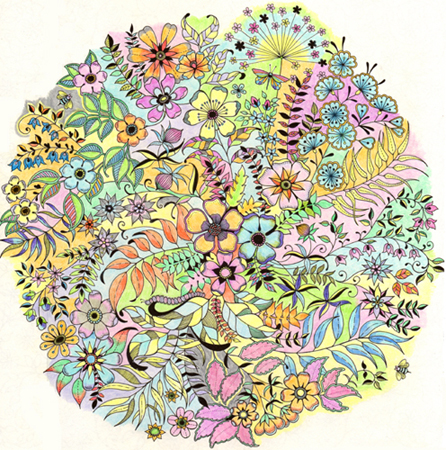 Michelle Casey's finished Secret Garden page. Faber-Castell Art Grip colour pencils were used to colour this. Today I thought I’d share my first coloured page in Johanna Basford’s Secret Garden with you along with imparting some more reflections on colouring. Recently, I was compelled to buy the book because I hoped it would help me to focus in the studio. You see, despite my best efforts, I’m the type who allows my worries to rule my head… some days this really paralyzes my sense of creativity. The moment I spied Secret Garden, I remembered how colouring once helped me cope with childhood stressors. I hoped it might do the same thing for me now; and, it did! In the last little while I’ve accomplished more work than ever… all while colouring my daily demons away!
The Meditative Benefits of Colouring…
Devoting time to colouring reminded me of how important it is to nurture a sense of fun in the studio. It made me more aware of mediums (ie. crayons, pencil crayons) I enjoyed using as a child and the sense of freedom they imparted. Feeling a colour pencil in my hand again was good; I remembered how important it was to hold it just so and put the right amount of pressure on it to elicit bold or subtle nuances of colour on paper… and how beautiful it is to layer colours upon each other. As a child colouring magically affected my imagination. Little did I know then that it also had benefits akin to meditation; as with the latter: it can help you sleep better; reduces stress; improves your health and sense of self-awareness. With regards to the latter, it certainly tuned me into my creative inner voice (See: Awakening the Secret Garden within Part I).
Using Colouring to Escape & Much More…
Recently a friend commented on how he used colouring as a tool to escape from the bullying of an angry parent. That got me thinking about the journeys colouring took me on as a kid. I too turned to colouring to soothe nerves brought on by family battles. When I got my first set of Crayola crayons, I fell in love with them instantly. I took joy in memorizing each and every one of their names: lemon yellow, cornflower blue, carnation pink, etc…. Like collage, colouring allowed me to create worlds of my own choosing; ones that were much rosier than the one I was living in. It gave me a sense of freedom when I had none. If I felt like it, I created whole monochromatic worlds of blues or reds. Other times, when I grew tired of straight colouring, I inscribed Zentangle-like patterns onto colouring book images. I experimented adding light and shade to images as well but it didn’t take me long to realize that I didn’t need to mimic the colours or textures of the real world – my colouring book was a free-for-all space; a place to break the rules and to breathe life into ordinary paper with colour! That sense of freedom allowed me to develop a personal relationship to colour, texture and line. Finishing an entire book never spelled the end of its use either. I continued to copy, trace, cut out and collage my favourite imagery onto greeting cards and school projects. As I did this, my brain began to take in the contours and shapes of things and that in turn fostered a sense of drawing, composition and collage. As I think about those times, I realize that colouring books were like mini experimental visual art labs. They were a great place to develop and expand my creative skills while simultaneously enjoying myself… most importantly, they provided me with a space to imagine a brighter world and to trust in and connect with my inner voice.
As in the past, I’ve also extended the life of Johanna Basford’s Secret Garden; recently, it’s inspired me to give shape to a new piece which I’ll share with you soon. I’d love to hear your fondest colouring memories. Were they an escape for you? Sheila Cain-Sample, you’re still colouring now; for you, the magic continues!
Share Your Secret Garden Pages!
PS I was delighted to hear from a number of you who decided to purchase the book. Did you know Basford is collecting images of coloured pages for a Secret Garden Facebook album? If you’ve completed one, why not send her a copy? I’m sending in mine! As well, she just published a Secret Garden postcard colouring book – see the link below for more information… wouldn’t it be cool to send a hand-coloured postcard to a friend!
Other Related Links:
Secret Garden: 20 Postcards
IMMRAMA Institute: Everyday Meditation for People Who Don’t Like to Meditate (Colouring as Meditation)
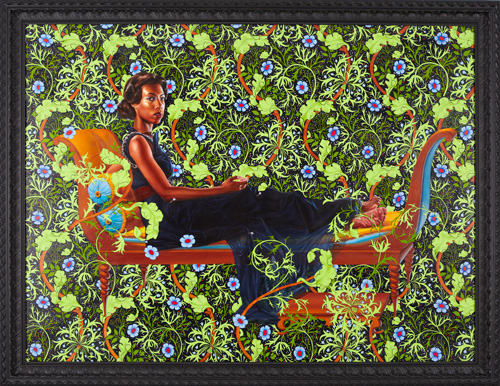 Kehinde Wiley, Juliette Recamier, 2012, Oil on linen, 72 inches x 96 inches quotes Jacques-Louis David's painting (see below) On the heels of Black history month, I’d like to share some reflections about art history and introduce you to painter Kehinde Wiley.
While studying art history at university, one of the most eye-opening and explosive areas for me as a woman of colour, was investigating issues of race and identity in the works of artists of colour. Because we live in a world that’s become increasingly global and as we strive to connect with those from diverse cultures, I think it’s vital to understand some of the troubling issues they’ve been grappling with for centuries.
Although I ingested information about Black cultures in America and Africa through music, comedy shows and film, I never really understood their meaning until I took art history. Up until my early 30’s, I was in the dark with regards to the histories of Black peoples. If you read my blog post on my collage “Mrs. S” you’ll learn why. While I’d heard about Martin Luther King Jr. through a 1960’s pop song, I wondered why Black Americans continued to complain about equal access and rights in North American society. Like women, they’d received the right to vote; they’d been freed from slavery centuries before – what was still wrong in the mid 1990’s? Then I took Art and Feminism and Photography and Anthropology courses and they rocked my world. I couldn’t believe how derogatively people of colour, African peoples amongst them, had been treated by certain White cultures. I wept for many months reading their heart-breaking stories. I wondered why many Blacks hadn’t taken to violent means to set right their ill treatment throughout history. Instead, I was amazed to see so many become creative souls, taking up the pen, the brush and other creative means to help enlighten and heal themselves and the world. It was so inspiring.
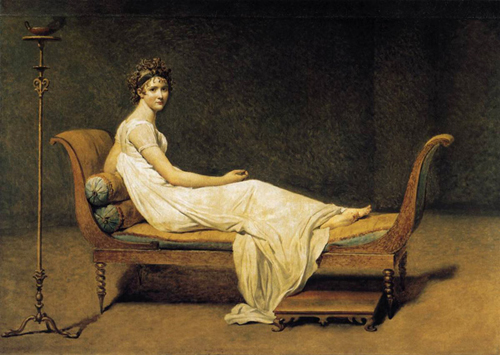 Jacques-Louis David, Portrait of Juliette Recamier, Oil on canvas, 1800, 68.50 inches x 88.58 inches For me, Black painter Kehinde Wiley is one such artist. He appeared to me almost as if in a dream… actually, while this insomniac was listening to late night radio. Through his art, Wiley asks: “Who I am in the world?” and “How do people who look like me fit into the broader cannon of art history?” An accomplished painter who studied his craft in St. Petersburg (the former Soviet Union), the San Francisco Art Institute and Yale, he hails from Los Angeles, California. His mom, a well-educated single-parent, sent her young sons to a free art program on the weekends to keep them off the streets during a time of unprecedented gang wars. Wiley excelled in art and continued his studies in the area of painting noting it made him feel special in the world. Now a highly respected American portrait painter his most well-known for body of work, “The World Stage”, depicts young Black men from America and around the world. In his latest series “An Economy of Grace” Wiley invited Black women from the streets of Harlem to participate in his latest portrait project. Attiring them in elegant designer Givenchy gowns he set them against ornate botanical backgrounds reminiscent of Art Nouveau or William Morris wallpaper designs. Positioning them in classical poses that mimic those used in the portraiture of high society European women throughout art history, the full effect of his compositional strategy gives the every day Black woman a feeling of great dignity perhaps denied to her in real life roles today and throughout history, art or otherwise. Portraying these women in such a distinguished fashion, Wiley bestows upon them a sense of empowerment and grace. The title of this series, “An Economy of Grace”, hints at the fact that Black women haven’t been paid the love and respect that they truly deserve from society. Throughout art history they’ve been stereotyped… eroticized as deviant sexual types or mammies. Wondering where women like the resilient, intelligent, resourceful Black women who raised him were, he set about remedying this situation through his portrait series. And, although Wiley has done portraits of famous sitters, this series that elevates and makes visible ordinary Black women seems close to his heart. Going beyond a visual critique, Wiley’s also auctioning off the gowns the women wore in these portraits to financially support their communities. On and off the canvas Kehinde Wiley’s a creative force to be reckoned with.
To learn more fascinating facts about Kehinde Wiley’s “An Economy of Grace” be sure to review the video link below where you’ll learn his method for choosing models off the streets; what makes his perfect model (you’ll be surprised); why he chose to portray the women in designer gowns and, most illuminating, more on the inspiration behind his title for the show… among other interesting reflections. He’s such an eloquent speaker!
Other Related Links:
Kehinde Wiley “Economy of Grace” Interview on CBC’s Q (February 2014)
Kehinde Wiley Website
The World Stage: Interactive Map (The Jewish Museum)
February 2012 Bits & Bytes: The Art of Wangechi Mutu
Please Note: I’ll be taking next weekend off. I’ll be back on March 16, 2014. Have a great week!
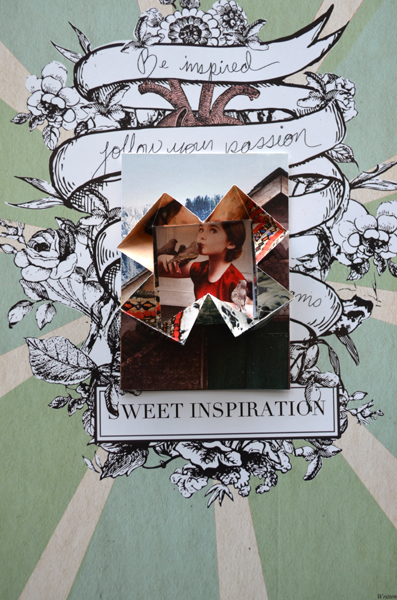 A peek inside my collage/origami lotus flower artist trading card... Hello! This is a follow-up to last week’s article in which I mentioned creating an origami/collage fusion-inspired artist trading card (ATC) using the lotus flower design as inspiration. Today I’ll share some tips on making one with you…
After showing my husband Kevin some of my origami lotus flowers, I noticed he kept on opening their centres to see what image was inside. Since this section consisted of a small square, I thought it would be neat to create a tiny collage right there in the centre. So I made a test ATC and voilà my Japanese-inspired ATC was born!
As I reflected upon it, it reminded me of one of those fortune teller origami paper game pieces I played with as a kid. You know the ones with the numbers on the outside and the fortunes on the inside? Soon I realized with this ATC design I could get three cool images in one: a background setting, a patterned origami exterior and a wonderful surprise image set in the centre of the lotus flower! One could even put a short quote or fortune inside the lotus if they wished! Here are the steps for creating this quick and easy ATC…
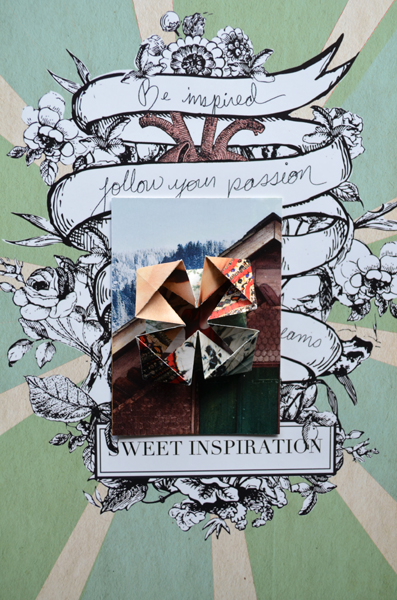 The exterior of my lotus flower artist trading card... note it's been photographed against a cool ad I found. 7 Easy Steps to Making Your Collage/Origami ATC:
Supplies: glue stick, double-sided tape, scissors, exacto knife, ruler, pen & blank ATC card. Optional supplies: stickers, permanent pens, colour markers & bone folder.
1) Cut out a perfect 3 by 3 inch square from an interesting magazine page. By “interesting”, I mean choose something with intriguing lines, textures, patterns and colours.
2) Fold your square into an origami lotus flower design. (See AOE instructions.)
3) Open up the centre square of the flower; make and glue a small collage consisting of one to three images in it. For these I kept it simple and used only one image. You don’t have to cover the whole square; you can incorporate its background into your collage as well.
4) Choose a magazine page that complements the colours of your lotus flower for the background of your ATC.
5) Trace your ATC card onto the magazine page; cut it out and glue it to your card. Trim the edges with an exacto knife if necessary.
6) Decide where you want to place your lotus flower; use double-sided tape to stick it on your card.
7) You can also add words, quotes or other interesting textures to the background of your ATC… on one of mine I included some “bling” – faux diamonds stickers!
Notes:
1) Your origami will look less wonky and fit together beautifully if you cut it out in a perfect square (using a ruler!) and fold it three times over with your nail or a bone folder.
2) Use a nice mid-weight paper from a magazine for your flower. I noticed that cheap, thin magazine paper tore easily while thick glossy paper cracked when I folded it.
3) An ATC is 3.5 by 2.5 inches; a 3 x 3 inch square, once folded, fits perfectly on it and is easy to work with when collaging a piece for the centre… anything smaller and you’ll need tweezers!
CYW Collage/Origami ATC Trade Challenge!
Best wishes with this project. As usual, if you test it out, I’d love to see your handiwork. Also, I’ll trade a collage/origami ATC of mine with the first person who sends me the definition of “origami”!
Other Related Links:
Significant Contributions: An Origami Art Project Unfolding
Artist Trading Cards: History, Rituals, How To’s
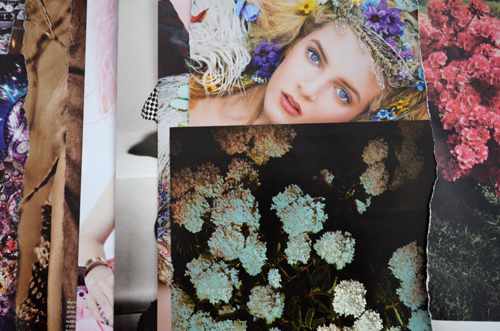 A selection of my origami magazine papers... For years, I’ve longed to make origami but haven’t been successful. You see, It’s embarrassing to say, but I’ve never been able to follow the written or diagram instructions on how to make it. I remember once trying to fold a simple boat, and no matter many times I tried, I couldn’t get it right. Frustrated, I figured origami and I weren’t kindred spirits. So, you can imagine my apprehension when friend artist Cristiane Doherty invited me to participate in an Ottawa-based community origami/art installation project: Significant Contributions! Envisioning it probably consisted of folding hundreds of paper cranes (a veritable origami nightmare for me!), I told her that I couldn’t make origami for beans! She gently urged me to check out two flower designs posted on her organization’s website (AOE – which is hosting the project). If I couldn’t make one, she said I could donate an ATC (Artist Trading Card) which reflected what art meant to me; the project’s overall theme is: community, communication and contribution. I decided to at least give the simplest design, a lotus flower, a try. And guess what? I succeeded in creating my first official piece of origami! I was amazed – the stars must’ve surely been aligned that day! I had so much fun, I made 40 more! Believe me this project, in which artist Karen Goetzinger will be transforming these paper flowers into a quilt-like structure, needs thousands – five thousand to be exact! The piece will occupy a large space inside the Shenkman Arts Centre in celebration of its fifth anniversary.
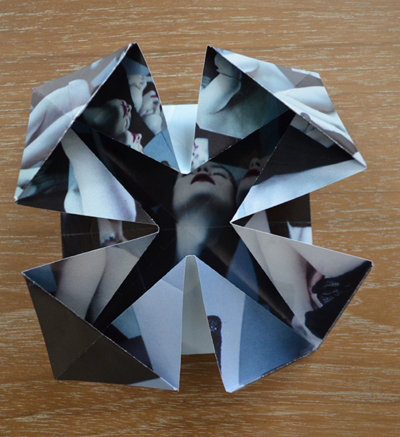 Each folded lotus flower reveals a surprising result... I found this one stunning! Each piece revealed its own design of chance…
While folding lotus flowers, I found origami to be such a calming, meditative activity; it’s infectious, too! Why else would I have produced 40 pieces without so much as glancing at my watch! Do you know what compelled me to keep folding flowers? Their beauty and my curiosity! Since one can use any type of paper to make a flower; I chose magazine pages because I have plenty of them to recycle. In my element, I selected pages filled with luscious colours, textures and designs: skin, silk, flowers, diamonds, tattoos, graffiti, natural elements and even smoke! My colour palette reflected many spectrums: bright and bold; glittering, black and white, neon, soft subtle pastel and earthy tones. And although I wasn’t using traditional origami paper, the pieces still turned out as cool as ever! The great thing about making these with magazine paper is that you never know what the end result will look like. If you try one, you’ll know what I mean. I worked with anticipation as each piece was folded into its own unique design of chance! Being a curious soul, I also asked, “what if?” What if I make a 7, 6, 3 or 2 inch square lotus flower? Could I handle it?! Yes, I could! What other kinds of paper might be neat to use – I pulled pages from a Japanese manga novel as well! I wondered too if I could create a kind of origami/collage fusion. I noted when I showed Kevin (my hubby) finished pieces he continually unfolded them at the centre to see what imagery was inside. I realized here, in this tiny square area, I could make a miniature collage! Because he’s my muse, I tested my idea out on an exquisite ATC Valentine card for him! Accepting this origami challenge has taken me in many exciting directions. I’m even considering collaging a series of lotus flowers for my studio or office wall!
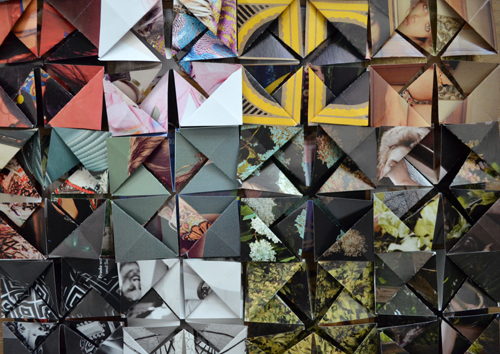 A grouping of lotus flowers so cool. This month I donated 40 to AOE! Be part of the project!
As I continue to make origami, I invite you to participate as well… even if you only submit one small piece! You are, after all, part of my virtual Ottawa community. I extend a call out to you ATCers too if you’d rather make a card based on what art means to you. Wouldn’t it be amazing to have something made by your own hands to incorporate into a public art piece? Wouldn’t you love to say: “I’m part of an art exhibition in Ottawa, Canada or North America?!” The Shenkman Arts Centre’s a beautiful contemporary space with high dramatic windows and ceilings – it’s where I participated in the 2012 Gharana Festival. Professional award-winning artist Karen Goetzinger, known for her work constructing mixed media textiles, is leading the project; her piece “State of Transparency” was an award finalist in ArtPrize’s 2011 international competition. Karen’s background in fine arts and fashion design, along with her knowledge of couture construction and quilt making, make her an excellent candidate for the task of overseeing the integration of everyone’s work into a final stunning piece! As one who values the contributions of every day folk into public art projects, I believe there’s no better way to celebrate community than being part of a collaborative project of this kind. Kudos to Cristiane Doherty and Karen Goetzinger for dreaming up this wondrous idea as well as everyone involved in bringing this marvellous vision to life!
How YOU can contribute:
1) Make origami*; there are two flower forms to choose from: Camellia & Lotus;
2) Donate paper for folding (any kind);
3) Make an ATC that reflects what art means to you OR
4) Send in a reflection about how art has affected your life.
(* A suggested size for flowers is a six inch square; they’re also accepting a variety of sizes – the more the merrier!)
All these will be incorporated into the quilt. To learn more about the Significant Connections Project as well as Karen’s visual conception of the piece, be sure to visit AOE on-line where you’ll find a more detailed project description; Liana Voia’s video featuring Cristiane and Karen as well as origami instructions. If you decide to contribute in any form, I’d love to know. I’ll also be happy to send you a photo of the finished installation! The project unveiling will be held in June 2014.
Note: The deadline to submit each month as well as participate in origami-making sessions at the AOE Gallery is ongoing until June 2014 – see AOE for more information on this.
Other Related Links:
Artist Trading Cards: Bits & Bytes (featuring an ATC by Cristiane Doherty)
The Birth of Collage Your World
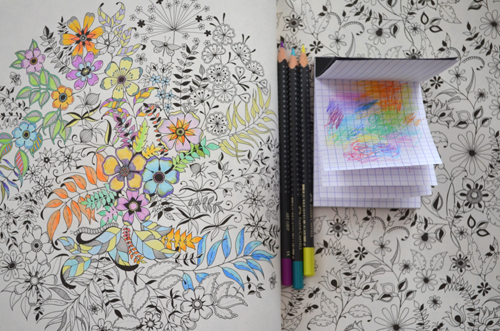 My two-hours' worth of colouring in progress in Johanna Basford's "Secret Garden" … I told the interviewer, I believed stories are found things, like fossils in the ground, he said that he didn’t believe me. I replied that this was fine, as long as he believed that I believe it. And I do. Stories aren’t souvenir tee-shirts or GameBoys. Stories are relics, part of undiscovered pre-existing world. The writer’s job is to use the tools in his or her toolbox to get as much of each one out of the ground intact as possible. Sometimes the fossil you uncover is small; a seashell. Sometimes it’s enormous, a Tyrannosaurus Rex with all those gigantic ribs and grinning teeth… (Stephen King, excerpt from On Writing, pp. 163-164)
Above is a favourite passage of mine from Stephen King. It excites me because, as a collagist, it’s exactly the way I view my process. You may recall my 2012 L’invisible collage zine cover features a young woman who represents the archaeologist within me. Likening fiction writing to excavation, King reminds us to look deeply to uncover what lies buried deep within us; that these finds may be small and surprising, great or terrifying! It takes courage to embark upon such a journey of discovery. Some of us take great pains to keep what’s buried beneath hidden, while others throw caution to the wind and take great leaps of faith in uncovering what’s lies there in the hopes that the bounty it yields will shed light into life, ourselves and what lies beyond. This is one of the greatest skills an artist can possess: the ability to be still, to be present and to focus in order to be aware of that inner voice that guides us along the path to a kind of creative personal archaeological journey…
It’s been ages since I’ve coloured just for fun…
On Friday afternoon I sat in the shopping mall colouring in Johanna Basford’s Secret Garden. Because I’m reading King simultaneously, my mind jogs back and forth between the offerings of each artist/author. It doesn’t take long for me to realize that colouring too, is a form of excavation! It’s been ages since I devoted myself to laying out a luscious set of colour pencils and having a go at colouring a picture just for fun … since I was at 9 or 10, I think. As my knowledge in art grew more sophisticated, I abandoned my crayons and pencil crayons for markers, watercolours, inks, acrylics and oil paints. Although a part of me missed the former, I felt they were the play things of childhood. Decades later while attending a workshop by artist Kelly Kilmer, I spied a beautiful journal she’d made. It was filled with collage and the kind of colouring I did as I kid. Surveying and admiring its pages awoke a deep longing within me. I felt perhaps it was okay if I took up my pencil crayons and crayons again. For so long, while pursuing my fine arts degree, I’d neglected to embrace these mediums I’d learned so much from. By this time art making was also a scary chore for me. I stopped being as daring as I was as a kid; I forgot how to have fun playing and experimenting with my colouring tools which often led to that all-important question that drives all good art making: “what if”. That was several years ago; I’ve been attempting to rectify this situation in my art practice ever since…
I’ve always had a give and take relationship with colour…
So, like I said, I’m sitting in the mall colouring in my book hoping no one will notice that, as an adult, it might be a weird thing for me to be doing! I decide, if anyone asks, I’ll say its therapy! And, it really is! Coming out of a bad year, I’m will to try anything that’ll jump start my creative momentum again! As I begin to colour, the world around me fades as I focus all my faculties on the page. The deep-fried smell of french fries temporarily loosens its grip on me. The sound of the crowd becomes a rhythmic murmur. As I contemplate the colours of a flower petal, leaf, or stem, I let each image determine what colour it will be. I go with an intriguing flow that emerges when I hear each image call out to me and name what colour it should be. I never realize until that moment, that this has been my colouring strategy since childhood! – no Johannes Itten colour theory for me! This is the give and take relationship I’ve always had with colour. It’s an easy, intuitive one; I listen carefully and let the voices on the page and in my imagination guide me. It’s easier than having a pre-determined colouring scheme. Although, sometimes the voices make decisions I don’t entirely agree with and I do my own thing. But often, I have to admit the choices they make satisfy and pleasantly surprise me. While colouring the leaves for instance, I learn that they want to have as much colour variety as the flowers. So as well as having multi-coloured flowers, I have multi-coloured leaves! My secret garden is like a rainbow! While colouring, the voices sometimes suggest I make more daring decisions like adding a frosty grey to the edges of a solitary flower. It’s my way of making the image unique; it’s a small, bold move to choose a sombre rather than a bright colour for a flower. It’s my new tonal take on the flora and fauna of this exciting new world Basford has drawn for me… it’s one way I can make it mine by bringing it to life with colour. As I colour, I also make best friends with certain pigments who want to be placed everywhere on my page! – a lemon-yellow, a light blue and violet, so I indulge them. Perhaps I go overboard with this, but its okay; after all, in the world of my imagination – anything goes! Afterwards, I ponder what draws me to these colours? Something in my past? Then I remember yellow is my father’s favourite colour and light blue, my mother’s. That violet is the precisely the colour of my favourite bathing suit. As a child, these colours were sacred to me; as they are now … so incredible.
Tiny facets of myself emerge…
In all these ways, through colouring, I excavate tiny facets of myself allowing my imagination and the voices inside me that accompany it to guide me. I’m deeply aware of who I am at the moment and the makeup of my being. The fossils and relics I uncover are ephemeral; they’re associated with my memories of colour; the feelings and attitudes I want to convey through them as well as how I see the world. All I learn here will eventually feed into my collage work. Even through the simple act of colouring, I can make something uniquely mine. It’s an empowering, freeing feeling and all it takes is letting go, listening and getting lost in the moment.
Did colouring take you on such a journey as a child? Do you still play with your crayons or pencils crayons? Where do they take you? What do you uncover about yourself through them? I’d love to know…
Other Related Links:
CYW: February 2014 Bits & Bytes
Due to my big move and settling into the new place (still), I noted I hadn’t made any time for one of my favourite pastimes: reading! In December I began noticing a whole slew of books I’d like to read and bought a few to start. Thought I’d share some reflections about them with you…
 365 Gratefuls: Treasures, Big and Small (Book Cover) by Hailey & Andrew Bartholomew 365 Days of Grateful
There came a point in Hailey Bartholomew’s life when she felt so depressed about her existence in this world, she decided to seek counselling from a life coach who advised her to seek out sincere moments in her life for which she was grateful. As one who had rarely or perhaps never thought of doing this before, she decided to give it go. Finding gratitude in the small, mundane moments of everyday life, especially in the things and people she once took for granted, her 365 days of being grateful resulted in a 360 degree change of attitude. Bartholomew’s gratitude journal took the form of a photographic one filled with Polaroid camera shots… the results are breathtaking moments: clothes on a line; a heart-shaped cloud floating in the sky; her garden in bloom and drawings by her kids. One of my favourites is a dinner plate concocted by her husband featuring a mound of spaghetti on which he has written “I love you” in tomato sauce… so sweet and romantic! Another thing I liked about this book is that Bartholomew includes contributions by fans of her initial Grateful project which makes for a wonderfully diverse selection of “gratefuls”: all kinds of art work, journal excerpts and poetry. It’s a great gift to inspire oneself with or to lift the spirits of a friend.
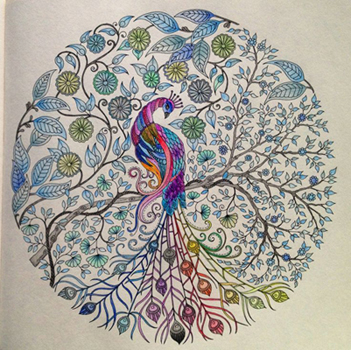 A beautiful page coloured by a fan of The Secret Garden colouring book... Johanna Basford’s Secret Garden
As a kid I loved colouring Doodle Art posters. Do you remember those big poster-size ones with tons of tiny details to colour in? They often depicted images from fantasies of planets, mythological creatures and the natural world. Some of them had imagery embossed onto rich black velvet paper. I was so engrossed by them! I would look at them and say: “It’s going to take me FOREVER to colour that!”– ah, but back then I was a kid with all the time in the world to do such things! Anyway, they also inspired me to make my own drawings and helped me to develop a keen sense of colour as well as enhance my colouring skills. Recently, I picked up Johanna Basford’s Secret Garden, a colouring book, and it whisked me back to those days. Inspired by the natural world, it’s filled with fantastical flowers, plants and animals. Basford invites readers to not only colour but draw and complete her images, traverse through mazes as well as find hidden treasures. I’m also using its design fragments for bits in my collages! This book is ideal for children and adults alike. For me, colouring has always been a meditative activity… there are times when I just want to quieten my mind and be completely absorbed in the moment – colouring has always been a prefect way of doing that. Be sure to also check out Johanna Basford’s Pinterest and Facebook pages on which she features the beautiful work of those who’ve coloured her glorious pages!
 On Stephen King and Writing On Stephen King and Writing
Several years ago, I wrote almost a year’s worth of short stories and discovered the writer within me. As with my visual journals, my tales were biographically driven. So I guess that’s what attracted me to Stephen King’s book “On Writing”. Besides devoting a chapter or so to grammar and such, King speaks of his life and how it shaped his stories. There were so many “aha” moments here … ie. Aha so that’s why he’s so awesome at conjuring up images of childhood and neglect… he’s had a charged and challenging one… little “Stevie” butted heads with many school authorities. As an adult he suffered from addictions to drugs and alcohol; the death of his beloved mother from cancer as well as survived a deadly hit and run accident (just like a tale from one of his novels) … and yet he still manages to rouse up a great sense of humour about things; even if it’s a tad bit dark at times. One of my favourite sections in the book is how he recalls creating a character, Carrie White, a teenager with deadly telekinetic powers, by going back to his high school days and recalling details of girls at his school who were bullied by others – he’s such an empathetic and brilliant observer of life. Another segment I loved was how he describes writing as a form of telepathy – it made the hair on my arms stand on end! Whether you’re a Stephen King fan or just want to improve your creative writing, this book is a must have for any library. As a visual artist, it’s stories such as these about crafting an art that propel my creative passion and imagination even further!
Stay tuned for more book reviews. I just got my hands on Jenny Doh’s Creative Lettering and Tonia Jenny’s Zen Doodle: Tons of Tangles… more on them soon! As well as a sample of how I’ve used Johanna Basford’s doodles in a collage!
Other Related Links:
NPR Interview with Stephen King
The Way of the Zentangle
How Writing Can Inspire Your Collaging
 November/December 2013 issue, Selvege. A favourite fabric-related magazine of mine... see link at end of this article Developing a Secret Code…
In Part I of this blog article, you learned of my fascination for fabric pattern prints and textures found in fashion magazines and my childhood home. While I noted, I used strips of these fragments for decorative purposes or to add colour or interest to a page, I also discovered they had the potential to convey personal meaning in my collages. They could allude to: life’s memories; be symbolic; evoke moods and emotions; add to the theme of a piece; give historical context or add insight into a character among other things. Realizing this excited me; it made me feel like I was developing secret code! Today I’ll share these ideas with you. Because I’ll be away next week, I’ve added some extra goodies in this segment for you!
Uncovering Your Personal Voice…
When choosing fabric (or other related) pattern prints and texture fragments for your collage/mixed media work, try to think about how they’ve been relevant to your life and the roles they’ve played. When composing an image, you have the opportunity to develop a personal visual language – instead of using a word to say something; you use an image to represent it. When you become good at it people will be able to “read” what you “write” with images. I’m always elated when people notice that I’ve used the same fabric pattern or texture element in several pieces. I know I’ve done my job when they can tell me what they’ve read into the recurrences of these fragments and what they might symbolize in my collage stories. More often than not they are right on; when they tell me something I’ve never thought of, I learn more about myself and those fragments.
If you haven’t had a chance to do last week’s homework (lol, I don’t blame you if you haven’t!), here’s a list of questions and reflections to help you discover your personal voice:
1) What kind of pattern prints or textures are you attracted to? Stripy, linear ones? Curvy, cosmic polka dotted ones? Textured ones: beaded, sequined, embossed or embroidered ones? Are there any others? Search for them in magazines, the real world or your memory in their various forms. See how many variations you can find say on a circular polka dotted style or a linear one and start seeing where you can use them to inform your pieces with visual meaning. Cut them out, draw, photograph or scan them and place them in a visual journal for your records so you can refer to them when composing.
2) Take time to investigate the history of classic patterns. Whether they’re stripes, plaids, polka dots, ginghams, leopard or camouflage prints they all have histories and functions and are associated with specific time periods and people. In fact, some of these patterns (ie. camouflage) are still evolving. I’ve always been drawn to paisley prints (my biological memory at work!); I love their intricate detail and floral patterning. While researching this print’s history, I found that it’s a blend of design from both Eastern and Western sources: India, the UK and Scotland – this is so cool considering my mixed cultural heritage. If ever I refer to this print in my collages, now you’ll know why!
Prints can allude to specific places… when I think polka dots I definitely think of America because my parents loved that US hit: “Itsy Bitsy Teeny Weeny Polka Dot Bikini”! Why do we think Africa when we see leopard prints or Scotland when we see plaids? Geographically-speaking the invention of fabric patterns can take us on an exciting journey around the world. In his quest to research certain fabric prints from Africa for his work, visual artist Yinka Shonibare, discovered they were produced in the UK. Where does your favourite pattern come from and what purpose(s) did it serve? What does it say about you as well as the culture(s) it comes from? Are there certain personalities associated with it that you have something in common with? Is it relevant to your life in some way? Can you use it in a piece to add that extra oomph to your work? These are intriguing questions to consider.
3) Once again, I ask you to take a walk down memory lane and recall the fabric pattern prints and textures of the fabric of your life. Do you remember details of your favourite outfit(s); your father’s much-loved tie or shirt; a movie star’s fabulous wardrobe; the décor in your homes; the architectural elements of memorable places you’ve visited, etc.? Be sure to include your landscape and urban excursions, too. Even the work of artists designing pattern prints are culled from their life experience. For instance, tapestry/wallpaper and fashion print designers William Morris and Sonia Delauney, respectively, drew their inspiration from observations of nature and the modern city.
My Walk Down Memory Lane…
I fondly recall the wooden mouldings of older homes I lived in as a child. I admired their beautifully carved elements above doorways, ceilings and staircases. I can summon up my parents’ tangerine-orange kitchen from the mid 1970’s: one side was covered with bold graphic floral wallpaper! The memory of a narrow navy blue and white tiled bathroom in our first home still haunts my dreams! It’s funny how the pattern prints and textures of things remain even if we don’t remember all the details of a particular time or place. They are precious souvenirs of a fuzzy past.
Examples of My Work…
 Michelle Casey, "Exile", Collage/Mixed Media, Journal Page, 8.5 x 6, 2011 In “Exile” I assembled elements that reminded me of my family home and the sense of alienation I sometimes felt there. I included patterned and textured elements: a handmade floral pot holder and tea towel (upper right) to suggest home cooked meals and the warmth of a family kitchen. The light blue wooden wall as well as the brightly painted façade of a house reminded me of the homes of outsider cultures like my Asian one – so different from the rest… filled with exotic objects and décor. I contrasted and added tension to this cozy scene with the addition of a fleshy-coloured leather n’ lace clad warrior girl reminiscent of Joan of Arc because I felt this rebellious religious figure’s spirit matched my own.
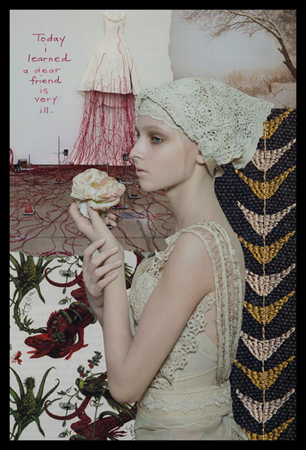 Michelle Casey, "Frozen", Collage/Mixed Media, Journal Page, 8.5 x 6, 2011 “Frozen” was born the day I learned a friend had cancer. While rummaging through magazines, I found a fragment of designer wall paper which depicted a disturbing scene of an iguana being strangled by a plant-like creature. In this collage, the blood-red iguana echoes the stringy vein-like tubes of blood emerging like tentacles from a gorgeous white evening gown. This dress once used for a joyous occasion now appears sickly and speaks so poignantly about mortality. I felt these two elements suited the anaemic looking child bride who grasps a delicate dying rose in her hand. In her beautiful embroidered floral dress she’s a bride of the winter of one’s life: destined for an untimely marriage with death.
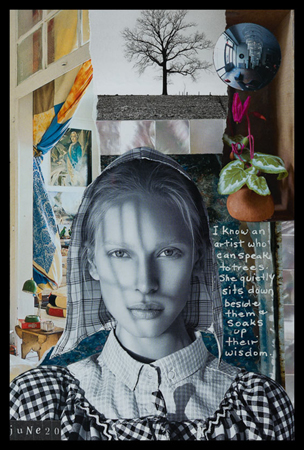 Michelle Casey, "The Tree Whisperer", Collage/Mixed Media, Journal Page, 8.5 x 6, 2011 In “The Tree Whisperer” I selected a figure clad in gingham and plaid. For me, these fabric prints symbolize the early days of farming and settlement in America. As a kid, I devoured Laura Ingalls Wilder’s: “Little House on the Prairie” book series. Since then I’ve always felt the kind of woman wearing this fashion was a wise, wholesome, hardworking one who possessed an intimate knowledge of the land – if anyone could talk to trees, she could.
The pattern prints and textures of the fabric of our lives have the power to add such a unique emotional and insightful depth to our art work. I hope you’ll find a way to bring your pieces to life through them.
When you speak through the images of fabric pattern prints and textures in your art, they may emerge not only on fabric but also drapery, carpets, wallpaper, wood panelling designs, etc.. Here are some great places to spot them:
– Fabric Stores or Warehouses (of course!)
– Paint/Wallpaper Stores
– Specialty Paper Shops (Ottawa: Paper Papier/The Papery; Paper Source online)
– Furniture Stores
– Fabric Remnant Bazaars (we have them here!)
– Vintage Clothing Shows
– Antique Fairs
– Garage Sales
*Note: I’ll be taking a break next weekend. I’ll connect up with you again on February 2, 2014. Have a great week!
Other Related Links:
Selvege Magazine
Part I: The Fabric & Patterns of Everyday Life
Going Gaga for Magazine Textures
|
|





















